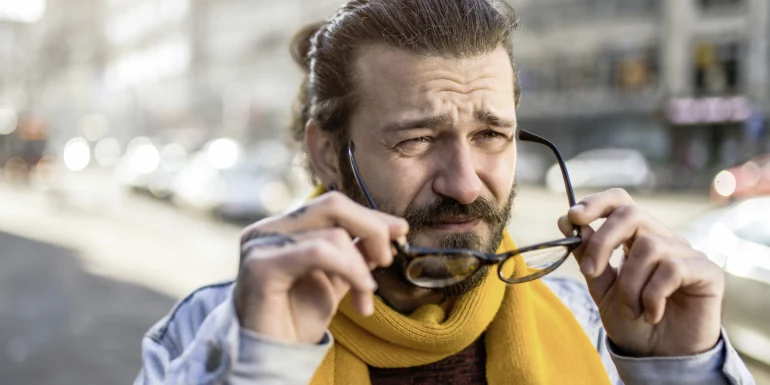
The eye: the structure and how it works
The eye allows us to identify colours, shapes and movements, and provides us with spatial orientation. It works in a similar way to a conventional camera, with the cornea, lens, retina and optic nerve forming the key vision elements.
The eye allows us to identify colours, shapes and movements, and provides us with spatial orientation. It works in a similar way to a conventional camera, with the cornea, lens, retina and optic nerve forming the key vision elements.
Overall, the eye consists of several different areas with different functions:
- Eyeball: the light is absorbed here and forms an image. This is transmitted to the brain as an electrical signal via the optic nerve. The eyeball rests in the bony eye socket of the skull and is protected by a cushion of fatty tissue. It is almost spherical in shape and its diameter measures just under 2.5 cm.
- Eye muscles: the eye is moved in all directions by six eye muscles, allowing us to follow objects with our eyes without having to move our head.
- Tear ducts: the tear ducts produce the tear fluid used to moisten and clean the eye, and to flush out any foreign bodies such as dust. The tear fluid also has bactericidal properties.
- Eyelids: the eyelids work together with the tear ducts to protect the eye. They distribute the tear fluid and can also close to protect against foreign bodies or even excessive light.
Structure and function of the eye
The cornea is the foremost part of the eye and is essentially the window to the eye. It acts as a front lens that allows light to enter and thanks to its natural curvature, is responsible for refracting light. It is around half a millimetre thick and filled with countless nerves that protect the eye. These nerves cause the lid to close at the slightest contact.
The sclera – the white of the eye – is very firm and together with the cornea, forms the outer shell of the eye. Apart from gaps at the front for the cornea and at the back for the optical nerve fibres, it encloses the eye completely. To protect the eye, the visible part of the sclera is coated with transparent conjunctiva.
The iris forms the coloured part of our eye, sitting like a colourful ring around the pupil. Depending on its pigment content, the iris is what determines our eye colour. Two muscles run into it, which dilate or contract the pupil according to the lighting conditions.
The pupil is the opening in the centre of the iris. It controls the amount of incoming light. In well-lit environments, the pupil is only opened slightly, while in darkness, it becomes wider to enable as much as light as possible to enter.
The lens focuses the light entering the pupil. It is elastic and can focus on far-off and close-up objects alike by altering its refractive power using the ciliary muscle.
The ciliary body is adjacent to the sclera and surrounds the lens. It produces aqueous fluid and uses its muscle – the ciliary muscle – to adjust between a close-up and far-off focus by changing the shape of the lens.
The area between the cornea and front of the iris is referred to as the anterior chamber. The smaller, posterior chamber lies between the iris and the lens. The aqueous fluid produced by the ciliary body flows from the posterior chamber into the anterior chamber through the pupil; there, it enters the blood at the junction between the cornea and sclera via the iridocorneal angle. It nourishes the lens and cornea and determines the inner eye pressure.
The vitreous body has a transparent, gel-like consistency, consisting of 98% water. It fills the inside of the eye and gives it stability.
The retina is located on the rear wall of the eyeball. It is extremely sensitive to light and possesses some 127 million light receptors: it is here that the incoming light is converted into electrical signals to allow the brain to process the information.
The choroid forms the middle layer between the sclera and retina. It contains a lot of vessels and is responsible for supplying the retina with blood and oxygen. It also keeps the temperature of the eye constant.
The macula lies at the centre of the retina. The slight indentation in its middle is known as the “fovea centralis”, which is where our vision is at its sharpest. More light receptors are densely packed here than anywhere else.
The blind spot is where the optic nerve leaves the eye. It is also known as the optic papilla. No light receptors are located here, which is why the eye is essentially blind at this spot.
The optic nerve is a huge bundle of nerve fibres that transmits the electrical signals emitted from the retina to the brain via the optic tract.
Our health advisors will provide you with helpful information on a variety of topics relating to the eyes along with tips on how to keep them healthy.
How does our sense of sight work?
Optical perception is the result of highly complex processes that work similar to those of a camera. That being said, our eyes are light-years ahead of technical appliances: they absorb more than 10 million pieces of information every second, and then forward these to the brain. As with a camera lens, light comes in through the individual components of the eye – the cornea, anterior chamber, pupil, lens and vitreous body – until the light beams hit the retina. This information is then sent to the brain for processing through the optic nerve.
But how exactly are we able to see?
No vision without light
Everything the eye sees is perceived in the form of light waves. This is why we are unable to see anything in absolute darkness. Light has to fall on an object to enable us to perceive it in the first place. For example, if we are looking at a tree, the light beams reflected by this tree reach the cornea through our vision system. The light beams first penetrate the conjunctiva and the cornea, and are refracted or collected by the cornea.
The iris: our camera aperture
To prevent the light from penetrating the eye unchecked, the iris acts similarly to a camera aperture: in darkness, the pupil dilates, while in light, it becomes smaller. Behind this, the light is refracted a second time – this time, by the lens. Depending on the distance to the object being perceived, the lens can alter its refractive power to regulate close-up and far-off vision.
Rods and cones
The light penetrates the vitreous body to reach the retina, which is home to more than 100 million photoreceptors. Here, we distinguish between two types of photoreceptors: the more light-sensitive rods are responsible for seeing colour, while the cones are in charge of grey shades and therefore seeing in black and white. On the retina, an upside-down image of reality initially appears.
Input to the brain
The photoreceptors convert the light into nerve impulses which are then transmitted to the brain via the optic nerve. Once there, the image is processed and then turned the right way up, marking the end of the process of seeing.

The expert provided the editorial team with advice and input for this article. Julia Pieh (doctorate in pharmacy and toxicology, pharmacist, naturopath) works in the Helsana Health Consultation Service.

Newsletter
Find out more about current health issues every month and get all the information you need about our attractive offers from all Helsana Group companies * delivered by e-mail to read whenever it suits you. Our newsletter is free of charge and you can sign up here:
We did not receive your information. Please try again later.
* The Helsana Group comprises Helsana Insurance Company Ltd, Helsana Supplementary Insurances Ltd and Helsana Accidents Ltd.